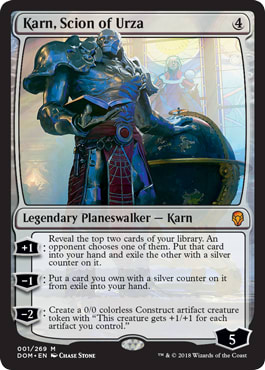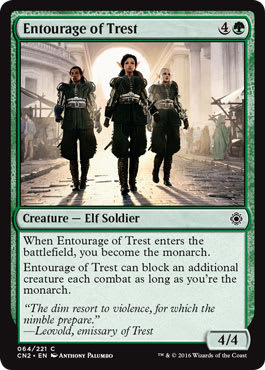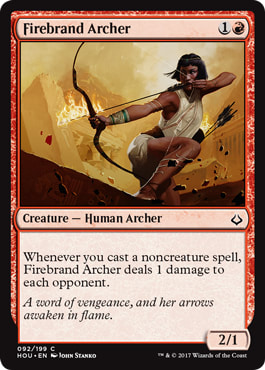In the great food chain of Magic decks, there lies a funny, obtusely named spot we've decided to call "Midrange".
What the heck is Midrange?
The others archetypes are easy. Aggro decks try to play the most efficient threats possible and try to finish the game while you still have cards stuck in your hand. Control decks are the opposite: they want to be the one with the full hand of cards even if it takes twenty turns to win. And combo decks? They can come in both fast and slow varieties, but their general rule is that they are working on a different axis of resources to win conditions that do traditional decks.
So where does that leave Midrange? The best way I define Midrange is that when I compare what I am doing on my turn to yours, I want to be doing something more powerful than you. Particularly focusing on turns 3-8, a Midrange deck is trying to maximize its effectiveness on that middle stage of the game. It doesn't have the raw efficiency to close out the game on turns 3, 4 or 5. But it is proactive enough that if it is able to stifle the opponent's faster start during the first 3 turns of the game then by that mid game every turn is one more turn for Midrange to pull ahead.
In formats like Standard, the defining cards of Midrange are planeswalkers. Nearly every planeswalker is designed to be a value engine: rarely can you get the full value of the card on any of its first activations, either adding or spending loyalty, so in order to justify their mana costs of typically 3-6 mana, planeswalkers need to stay on the battlefield for 2-3 turns to cement their effectiveness. Four or more turns and rarely will their caster lose the game.
But Pauper doesn't have planeswalkers. So if we're going to seek out incremental value, we're going to need to look someplace else. Instead, the two best ways to gain value in Pauper are two-for-ones and the Monarch mechanic.
Two-for-ones can come in three forms:
- As creatures with a powerful enter-the-battlefield ability, like Phyrexian Rager
- As raw card draw spells, the baseline being Divination, or its Pauper cousin, Mulldrifter
- As removal spells that can take out two or more threats for just one card, either all at one time, like Blazing Volley, Crypt Rats or Evincar's Justice or with flashback spells like Firebolt and Chainer's Edict.
The Monarch mechanic trades greater long term card advantage for an introduced element of risk. Every end step that you are able to keep the crown is one more free card drawn. And even though an extra card at the end of your turn isn't quite as powerful as an extra card in your main phase, there is nothing even close to the raw card advantage power level of getting to be the Monarch anywhere else in Pauper legality. But only three Pauper legal commons can grant you the Crown: the ![]()
![]() 4/4 Entourage of Trest, the
4/4 Entourage of Trest, the ![]()
![]() 1/3 deathtouch Thorn of the Black Rose, and the most popular choice of the three, the
1/3 deathtouch Thorn of the Black Rose, and the most popular choice of the three, the ![]()
![]() 2/4 Palace Sentinels. Notably absent from these options are the colors Red and Blue, unless you are using paper printed commons that are not on MTGO, in which case Red also gets the
2/4 Palace Sentinels. Notably absent from these options are the colors Red and Blue, unless you are using paper printed commons that are not on MTGO, in which case Red also gets the ![]()
![]() 4/4 Crown-Hunter Hireling. Blue on its own can't become the Monarch unless it steals it from another player. Boo-hoo for Blue.
4/4 Crown-Hunter Hireling. Blue on its own can't become the Monarch unless it steals it from another player. Boo-hoo for Blue.
The last key element to a good Midrange deck is keeping pace in the early turns by disrupting the opponent's strategy. Often this means cheap removal versus aggro decks. Sometimes it means hand attack or Counterspells versus combo or control strategies. But the purpose of this cheap disruption is to reach that midpoint in the game where you are doing more power things on each of your subsequent turns than your opponent can do on theirs.
So combining that winning formula of two-for-ones, long-term card advantage and cheap disruption, let's see how a few Midrange Pauper decks go to work.
Boros Monarch -- Pauper | Zane Sweetman, 5th Place SCG Pauper Classic, Roanoke
- Creatures (15)
- 3 Palace Sentinels
- 4 Glint Hawk
- 4 Kor Skyfisher
- 4 Thraben Inspector
- Instants (11)
- 1 Electrickery
- 2 Prismatic Strands
- 4 Galvanic Blast
- 4 Lightning Bolt
- Sorceries (3)
- 1 Firebolt
- 2 Battle Screech
- Enchantments (3)
- 3 Journey to Nowhere
- Artifacts (7)
- 3 Alchemist's Vial
- 4 Prophetic Prism
- Lands (21)
- 2 Mountain
- 2 Plains
- 1 Bojuka Bog
- 2 Secluded Steppe
- 3 Ancient Den
- 3 Great Furnace
- 4 Boros Garrison
- 4 Wind-Scarred Crag
- Sideboard (15)
- 4 Pyroblast
- 2 Electrickery
- 2 Gorilla Shaman
- 2 Kor Sanctifiers
- 2 Lone Missionary
- 2 Relic of Progenitus
- 1 Coalition Honor Guard
Boros Monarch is currently the both the most consistent and most commonly played Midrange deck in Pauper. My colleague, Kendra Smith has an excellent article on the history of the Boros deck in Pauper.
What you will observe about this deck is that it is the sum of all the pieces we described: a pile of two-for-ones, cheap disruption (mostly here in the form of removal), and a mid to late game that leverages the power of the Monarch mechanic. The two-for-ones are derived by recursion: first by cantripping and recasting the seven two-mana artifacts, and then with a few other recursion tricks you can do with Kor Skyfisher. The deck is built not only to have a mid game of Palace Sentinels, but also to hold the crown as long as possible through using cheap removal, go-wide bodies, and five Fog effects to blank the opponent's attempts to steal the crown. One other incredible advantage of the Boros deck is reach: playing nine main deck burn spells makes it easy to close the game out, even when the opponent is sitting at 10 or more life!
Next let's look at my favorite Midrange deck:
Rakdos Midrange -- Pauper | SteveJeltz
- Creatures (16)
- 2 Gurmag Angler
- 3 Phyrexian Rager
- 3 Thorn of the Black Rose
- 4 Chittering Rats
- 4 Firebrand Archer
- Instants (9)
- 1 Electrickery
- 1 Magma Spray
- 3 Terminate
- 4 Lightning Bolt
- Sorceries (13)
- 1 Divest
- 1 Duress
- 1 Flame Slash
- 1 Raven's Crime
- 2 Read The Bones
- 3 Chainer's Edict
- 4 Night's Whisper
- Lands (22)
- 6 Mountain
- 4 Swamp
- 1 Bojuka Bog
- 1 Rakdos Guildgate
- 2 Radiant Fountain
- 4 Bloodfell Caves
- 4 Rakdos Carnarium
- Sideboard (15)
- 4 Pyroblast
- 3 Duress
- 3 Electrickery
- 3 Gorilla Shaman
- 1 Dead Weight
- 1 Relic of Progenitus
So, I will readily admit that this is my pet deck. If you ever see me playing at a competitive Pauper event there is a good chance I will be on some version of Rakdos.
This deck is built from the sideboard up. I adamantly believe that the best sideboard cards in all of Pauper are in the colors of Black and Red. Pyroblast, Gorilla Shaman, Electrickery, and Duress are not only incredibly efficient, but are also incredibly flexible disruptive answers. Pyroblast is as equally powerful against Delver of Secrets as it is Dimir Alchemy or even Blue-based Tron. Electrickery is awesome against Slippery Bogles, Elves, Spellstutter Sprites, and even has game against decks like Stompy, since it can zap a Quirion Ranger or use its untargeted mode to hit the Silhana Ledgewalker when they go for an Elephant Guide or to add counters via Hunger of the Howlpack. Duress is for any both for any deck slower than you to disrupt their early plays or force through a key card like Thorn of the Black Rose, but it also is a valuable player against combo decks like Izzet Blitz, Tireless Tribe, and Bogles. Gorilla Shaman is Pauper's most famous Affinity hate, but it also has added utility against Boros Monarch, so much so that you'll observe that Zane's list hedges by playing fewer Ancient Dens and Great Furnaces in favor of basic Mountains and Plains. The singleton Relic of Progenitus may seem skimpy for graveyard hate, but this deck also plays a bunch of cards that utilize the graveyard. So it's really a compliment card to the Plan A of picking up your own Bojuka Bog with your four Rakdos Carnarium for when you need to hit their graveyard at instant speed. Finally, Dead Weight is there as a pinpoint answer to Atog and more importantly Tireless Tribe, but it can also just be one more generic removal spell against an aggro deck. It is not uncommon with this deck to sideboard up to nine cards in any matchup, and your main deck is built in such a way that rarely will you lose synergy by adding the correct answers.
As to the main deck, it's a pile of two-for-ones, both in creature forms and six extra spell-based "Draw Two's. It has a deep and diverse removal suite, and, of course, the Monarch. Gurmag Angler plays cleanup crew when your 2/2s can't get the job done. And the main deck discard helps you both to get information and also mise your important cards in challenging matchups.
The most curious card in the deck is Firebrand Archer. Combined with 22 instants and sorceries, this card gives the deck an important clock against Tron while in most other matchups it's an early play that will just trade off with a creature or their removal spell. It can also help you win through Moment's Peace and Stonehorn Dignitary since those two cards can blank any deck that has to attack to win. But the secret reason this card is in the build is that the deck desperately needs proactive two-drop. With four Rakdos Carnarium plus four Night's Whisper it is not usual for the deck to risk discarding to hand size if the opponent doesn't give us a way to interact with them early. But many other 2-drops have auditioned in its spot in my Rakdos decks, from Thermo-Alchemist, to Child of Night to Hand of Silumgar to Dusk Legion Zealot and Cuombajj Witches. Maybe even one of the Dominaria flexible twos like Caligo Skin-Witch or Ghitu Chronicler would fit well in this spot.
If you're looking for other Midrange options in Pauper, there are also other successful rogue builds out there. Orzhov Midrange is a neat Pauper deck that maximizes the effectiveness of the card Pestilence, one of Magic's original broken commons. There are also a few other regularly played archetypes that can pivot to a Midrange role: Dimir, with its top end of Mulldrifter into Gurmag Angler can be built anywhere from a combo deck into a pure control build. And Mono-Black Devotion, and old favorite with its haymaker Gray Merchant of Asphodel is a fantastic deck at leveraging life totals in axis with card advantage to either extend the game as needed or to shut the door at the right time. Even Kendra's Elves that we featured two weeks ago can feel like Midrange when it uses Wellwisher and Essence Warden to extend the game indefinitely, Distant Melody and Lead the Stampede to refill, and Viridian Longbow to close the game out.
Personally, for all your brewers out there, I'd love to see a Green / Red or Green / Blue Midrange Ramp deck that maximizes the power of Entourage of Trest, maybe with a spice of land destruction or Temporal Spring.
What do you think of Midrange in Pauper? Is it too reactive for you, or do you like being the one with the flexible game plan against everyone?
Keep having fun out there,
Rev David Wright


























